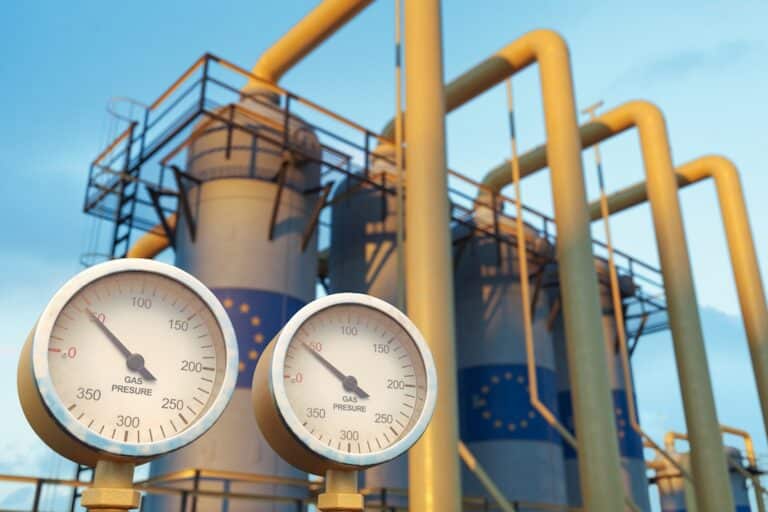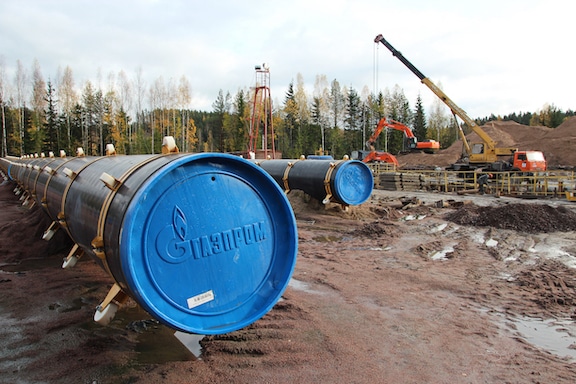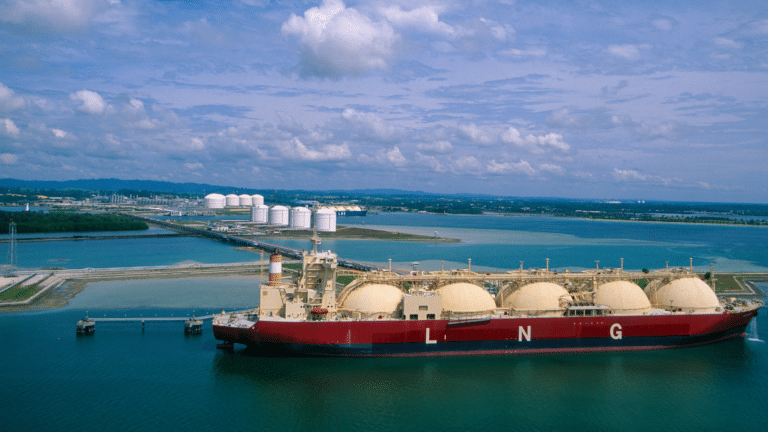This commentary represents the research and views of the author. It does not necessarily represent the views of the Center on Global Energy Policy. The piece may be subject to further revision. Contributions to SIPA for the benefit of CGEP are general use gifts, which gives the Center discretion in how it allocates these funds. More information is available at https://energypolicy.columbia.edu/about/partners. Rare cases of sponsored projects are clearly indicated.
A dearth of energy supply worldwide has been hastened by the Russian war in Ukraine. Europe in particular has for some time felt the effects of higher natural gas prices, a trend that began well before the war when European gas spot prices increased from under $10/million British thermal unit (mmBtu) in early 2021 to $24/mmBtu in the second half of last year before persisting at close to $30 for most of the first half of 2022. Tensions have been increasing in Europe due to lower Russian gas pipeline deliveries since early June 2022,[1] pushing prices to even higher levels—as high as $100/mmBtu and sustaining over $50/mmBtu.
Looking ahead, Europe may find itself increasingly cut off from Russian oil and gas supply. While this can be mitigated in part with new suppliers, European buyers will also be competing for that supply with growth markets in Asia that continue to look for both short-term spare and long-term contracted supply. This dynamic places a spotlight on a Western ally—the United States—and its natural gas and liquified natural gas (LNG) export markets, with a role to play in alleviating short-term crunches, as well as a potential opportunity for growth to meet medium-term needs. This commentary discusses current gas demand and how that is likely to change in the near to long term, explores the opportunities and risks inherent in expanding US supply to meet it, and concludes with the policy support required should expanding the natural gas and LNG industries become a priority.
Changing Market Dynamics
A natural gas market that was gradually tightening all through 2021 has been pushed into a state of alarm by the Russian war in Ukraine. Soon after the initial invasion of Ukraine, the European Union (EU) announced on March 8 the outline of a plan to cease its use of Russian gas—155 billion cubic meters (bcm) in 2021—entirely well before 2030, of which roughly 100 bcm would be potentially cut within a year.[2] This ambition to reduce Russian gas imports by two-thirds was confirmed with the publication of the REPowerEU plan on May 18,[3] which included a call for an additional 50 bcm of LNG in 2022.
Europe is rapidly seeking an alternative purchase of LNG and piped gas imports to help make the substitution. With the world already facing a limited growth of LNG supply in 2022 (plus 4 percent year over year in the first eight months of 2022),[4] Europe is paying lofty prices in the global LNG market to procure the incremental cargos, competing in particular with Asian countries. The situation has recently worsened due to much lower pipeline gas supplies coming from Russia, which are not likely to sufficiently meet Europe’s gas demand needs in the short to medium term (into winter but also beyond).
The marginal cargoes that have been diverted to Europe have largely been the ones with greatest flexibility. US LNG contracts largely do not have an attached destination clause and can be shifted based on market conditions, and the vast majority of new LNG volumes finding their way to Europe are coming from US terminals,[5] such as Cheniere Energy’s Sabine Pass in Louisiana and Corpus Christi facilities in Texas, Cameron LNG in Louisiana, and Freeport LNG in Texas (until it stopped exporting after an explosion on June 8). Those facilities have been able to take advantage of large differences between overseas and domestic gas pricing. Flexibility, as far as where their LNG is sold, is due to the fact that more than half of the contracted volumes are in the hands of international energy companies, traders, and European utilities, which are used to arbitrage between markets.[6] Over the near term, the LNG market—in the US in particular—will largely remain fluid to serve the market that is in greatest need.
US LNG exports increased an estimated 12 percent over the first eight months of 2022 to around 74 bcm.[7] However, there are limitations on how much higher the US market can grow in the near term. While it achieved export volumes close to its peak capacity of about 13 billion cubic feet per day (Bcf/d)—equivalent to over 130 bcm on an annualized basis—in April–May 2022,[8] volumes have been lower in succeeding months without the availability of Freeport LNG (which has a baseload capacity of 1.98 Bcf/d and peak capacity of 2.2 Bcf/d).[9] Meanwhile, some marginal additional LNG volumes will come online at the Calcasieu Pass facility in Louisiana later this year and into 2023 to add a further approximately 0.5 Bcf/d; the next large tranche of US LNG is expected to arrive in late 2024 to early 2025 at Golden Pass LNG in Texas.[10]
The growing tightness in the overall global market, however, leads to key questions of whether and, if so, how the US LNG industry could or should further expand to meet both Europe’s and the world’s needs for gas over the medium to long run. The shortage of natural gas could be exacerbated if Russian gas exports are structurally impacted by the exit of partners and service and technology providers, not just for piped gas to Europe but also for its LNG export business. The authors question, for example, whether Russia’s Arctic LNG 2 production facility will start on time in 2023.
Opportunities and Risks in Expanding Supply
The US natural gas industry is expected to produce roughly 97.1 Bcf/d this year, according to the US Energy Information Administration, while LNG exports should average close to 11.0 Bcf/d, a 13 percent increase over 2021’s annual levels (accounting for Freeport downtime).[11] LNG export projects currently under construction should add a total of about 6 Bcf/d of new baseload capacity beyond the existing 13 Bcf/d level with Freeport LNG (the additions include the recent final investment decision, or agreement to develop a project, of the Venture Global Plaquemines LNG project in Louisiana in May 2022 and that of Corpus Christi Stage 3 in June 2022).[12] There is an opportunity to sanction additional projects over the coming few years—the authors estimate a potential to add at least another 4–5 Bcf/d of US LNG projects. In total, this represents significant incremental demand, putting the onus on gas supply to keep up to meet it.
Europe’s need for LNG is large in the short term but extremely uncertain beyond 2030. There are, therefore, open questions around Europe’s willingness to commit to meaningful volumes under long-term contracts, given the continent’s desire to accelerate the energy transition (even faster due to fallout from the Russian war in Ukraine).
Europe will also scrutinize the carbon footprint of future gas sources, including LNG, putting additional pressure on US gas players to focus on limiting emissions from their operations. Both existing and new supply/projects would need to have a carbon footprint as low as possible. Measures to cut flaring (gathering gas currently being flared, 0.9 Bcf/d, could unlock some additional supply), reduce methane leaks and other operational emissions, and enable carbon capture or use of renewable electricity at liquefaction plants will be vital, particularly to attract European buyers. Some recent commercial deals—with Rio Grande LNG and Sempra’s Cameron LNG[13]—have included a responsible sourcing component that highlights an emissions reduction feature. Finally, with an eye on the energy transition, preventing overbuild will be important. Net-zero scenarios highlight the possibility that LNG exports could peak in the 2030s, providing a long-term risk for US LNG export facilities.[14]
Additionally, US LNG is not the only source of gas supply targeting Europe; other LNG suppliers as well as pipeline suppliers such as Algeria, Azerbaijan, and Eastern Mediterranean countries are hoping to replace missing Russian gas supplies.
But some signs of continued long-term demand from the EU for US LNG supply have been announced recently:[15]
- European-based Engie signed a 15-year sales and purchase agreement (SPA) for 1.75 million metric tons per annum (mtpa) with NextDecade’s Rio Grande LNG project in Texas.
- German utility RWE signed a 15-year heads of agreement (HoA) with Sempra’s Port Arthur LNG project in Texas.
- Poland’s PGNiG signed an HoA with Sempra at their Cameron and Port Arthur facilities.
- German utility EnBW signed two 20-year SPAs with Venture Global LNG for 1.5 mtpa from the Plaquemines and Calcasieu Pass 2 facilities, starting in 2026.
- British chemical company INEOS announced plans to begin trading LNG, with a 1.4 mtpa deal with Sempra projects.
Asian markets continue to be seen as the key growth area for natural gas. Asian buyers are finding gas to be an increasingly scarce source of energy in the near term but still view it as a critical fuel for several decades to come in order to limit the growth of and support a switch away from coal—as long as LNG is affordable. Demand includes traditional buyers from Japan and South Korea (where announcements have already been made with companies such as Hanwha Energy, POSCO, SK Gas Trading, and Korea Gas Corporation)[16] but also China, India, and other South/Southeast Asian nations (Malaysia’s Petronas recently inked a deal with Venture Global).[17] In particular, China has appeared as a leading prospective customer with 14 new LNG SPAs signed between Chinese companies and US LNG projects’ sponsors between October 2021 and July 2022, with contracts starting from 2022 to 2027.[18] These contracts support both existing projects as well as new projects that have yet to be approved, such as NextDecade’s Rio Grande LNG or Energy Transfer’s Lake Charles LNG in Louisiana. Affordability will be key: with the current high price of all sources of energy, including coal, relatively lower-cost US natural gas should prove attractive. In the long term, the price of US LNG would need to remain competitive to other energy sources for price-sensitive Asian markets; otherwise, there is a risk that these countries could stay with coal longer and then directly leapfrog to renewables. Finally, traders and portfolio players, such as TotalEnergies and even ExxonMobil and Chevron, present further opportunities with greater flexibility, allowing for cargoes to be sent to either Europe or Asia, or other destinations depending on need.
US gas supply should be able to maintain a growth trajectory over the next 3–5 years, helped by the current, more favorable domestic price environment, around $8/mmBtu, as well as a gradual increase in associated gas supply tied to oil production led by the Permian Basin in the Southwest. A high price environment in Europe and Asia is likely to last for years until new LNG export capacity comes to the market from 2025 to 2026 onward, which the authors see offering profitable returns to producers in several regions under $4/mmBtu.
US gas market participants would need to delicately balance the opportunity of meeting short-term needs for more gas supply and LNG exports with the reality of a global push toward decarbonization, which is expected to impact both future domestic gas demand and US LNG exports. Consideration of immediate gas demand must be weighed against the costs of infrastructure needed to connect producing areas with export sites (pipelines, storage, etc.), which at some point could turn into stranded assets unless they can be used to export decarbonized fuels.
Current gas supply appears adequate to keep up with most but not necessarily all the 6 Bcf/d of LNG export projects being built,[19] but sufficient capital/drilling activity as well as the removal of policy constraints would be needed to produce enough additional gas supplies to feed a further 4–5 Bcf/d or more of new LNG projects.
Policy Support for Growth
If policy makers decide that expanding the US natural gas and LNG industries is a priority, even limited to the near or medium term, adjustments would be required to efficiently accomplish the task. In recent years, some local, state, and federal policies—in addition to citizen opposition and investor wariness of potentially stranded assets—have constrained such growth, especially in the Northeast. The multiple issues facing the Mountain Valley Pipeline—from vacated build permits to lawsuits (from property owners and environmental groups) to the resulting massive cost overruns[20]—is a key example of this.
While issuing more export project permits would be a start, regulators would need to manage more closely key development steps, such as pipeline reviews/permitting and environment reviews as well. The recently passed Inflation Reduction Act came with an agreement to pursue permitting reform legislation over the near term. Of note, the Mountain Valley Pipeline has been specifically mentioned—notably by Senator Joe Manchin—as a critical early test case in this process.[21] How this reform legislation takes shape will be important to monitor. In addition, similar to what is happening in Europe, such infrastructure could be built to be compatible with the transport of other decarbonized energy sources such as renewable gas (biomethane), as well as hydrogen, to avoid these assets becoming stranded once fossil fuel use is limited.[22]
Investor and commercial support would be critical to unlock further potential for the US gas industry. At present, there is limited engagement between policy makers and investors in this regard—both around the potential for further gas industry development as well as for ways to factor key climate considerations into industry operations, as noted above. While prices are high and the near-term outlook is promising, questions remain around whether investors will deploy adequate capital to expand supply. For 4- to 5-plus Bcf/d LNG projects to move forward, a reinvigoration of the upstream would be essential, and any such new projects would need to align with energy transition efforts to remain relevant.
Notes
[1] Vanessa Dezem, William Wilkes, and Arne Delfs, “Germany Has Three Months to Save Itself from a Winter Gas Crisis,” Bloomberg, August 1, 2022, https://www.bloomberg.com/news/articles/2022-08-01/germany-heading-to-gas-emergency-with-russia-keeping-nord-stream-flows-reduced.
[2] European Commission, “REPowerEU: Joint European Action for More Affordable, Secure and Sustainable Energy,” March 8, 2022, https://ec.europa.eu/commission/presscorner/detail/en/ip_22_1511.
[3] European Commission, “Questions and Answers on the REPowerEU Communication,” May 18, 2022, https://ec.europa.eu/commission/presscorner/detail/en/qanda_22_3132.
[4] Bloomberg LP, “LNG exports by origin domicile,” accessed September 6, 2022.
[5] Dezem, Wilkes, and Delfs, “Germany Has Three Months.”
[6] Adila McHich, “Will the US Be the Home of LNG Price Formation?” CME Group, July 17, 2019, https://www.cmegroup.com/education/articles-and-reports/will-the-us-be-the-home-of-lng-price-formation.html.
[7] Bloomberg LP, “LNG exports by origin domicile,” accessed September 6, 2022.
[8] Jamison Cocklin, “US LNG Upside Seen Limited by Pipeline Capacity Constraints,” Natural Gas Intel, August 17, 2022, https://www.naturalgasintel.com/u-s-lng-upside-seen-limited-by-pipeline-capacity-constraints/.
[9] Freeport LNG, “Gas Liquefaction,” https://freeportlng.com/our-business/gas-liquefaction.
[10] Corey Paul, “LNG Project Tracker: Contracting Surge Accelerates Next Cycle of Export Projects,” S&P Global, July 14, 2022, https://www.spglobal.com/marketintelligence/en/news-insights/latest-news-headlines/lng-project-tracker-contracting-surge-accelerates-next-cycle-of-export-projects-70992920.
[11] EIA, “Short-Term Energy Outlook Data Browser,” accessed September 7, 2022, https://www.eia.gov/outlooks/steo/data/browser/#/?v=15.
[12] These include the remaining trains at Calcasieu Pass (3.8 mtpa), as well as the Golden Pass (18.1 mtpa), Plaquemines (13.3 mtpa), and Corpus Christi Stage 3 (10.4 mtpa) projects. Clara Tan, Caroline Evans, Daniel Stemler, and Michael Sultan, “Deals, Expansions, FIDs Mark Busy Week for US LNG,” Energy Intelligence, May 27, 2022, https://www.energyintel.com/00000181-01d1-d59f-a3df-addfe0670000.
[13] Jamison Cocklin, “NextDecade Seeks FERC Approval for CCS at Rio Grande LNG,” Natural Gas Intel, November 22, 2021, https://www.naturalgasintel.com/nextdecade-seeks-ferc-approval-for-ccs-at-rio-grande-lng/https://www.sempra.com/sempra-infrastructure-and-rwe-sign-heads-agreement-us-lng-supply#:~:text=Sempra%20Infrastructure%20is%20one%20of,a%2028%25%20reduction%20in%202021.
[14] IEA, “Net Zero by 2050,” May 2021, https://www.iea.org/reports/net-zero-by-2050.
[15] Michael Sultan, “US LNG’s Mega-Expansion,” Energy Intelligence, July 26, 2022, https://www.energyintel.com/00000182-3219-d68e-abf6-b339ebe60000.
[16] Ibid.
[17] Ibid.
[18] Paul, “LNG Project Tracker.”
[19] EIA, “Annual Energy Outlook 2022: Production,” March 3, 2022, https://www.eia.gov/outlooks/aeo/narrative/production/sub-topic-01.php.
[20] Charles Kennedy, “Approval for Battered Mountain Valley Gas Pipeline Could Be Accelerated,” OilPrice.com, August 2, 2022, https://oilprice.com/Latest-Energy-News/World-News/Approval-For-Battered-Mountain-Valley-Gas-Pipeline-Could-Be-Accelerated.html.
[21] Miranda Willson and Carols Anchondo, “Biden, Manchin Back Deal to Advance Mountain Valley Pipeline,” E&E News, August 2, 2022, https://www.eenews.net/articles/biden-manchin-back-deal-to-advance-mountain-valley-pipeline/.
[22] Killian Staines, “EHB Targets 28,000km of Hydrogen Pipelines by 2030,” Argus Media, April 5, 2022, https://www.argusmedia.com/en/news/2318957-ehb-targets-28000km-of-hydrogen-pipelines-by-2030.






